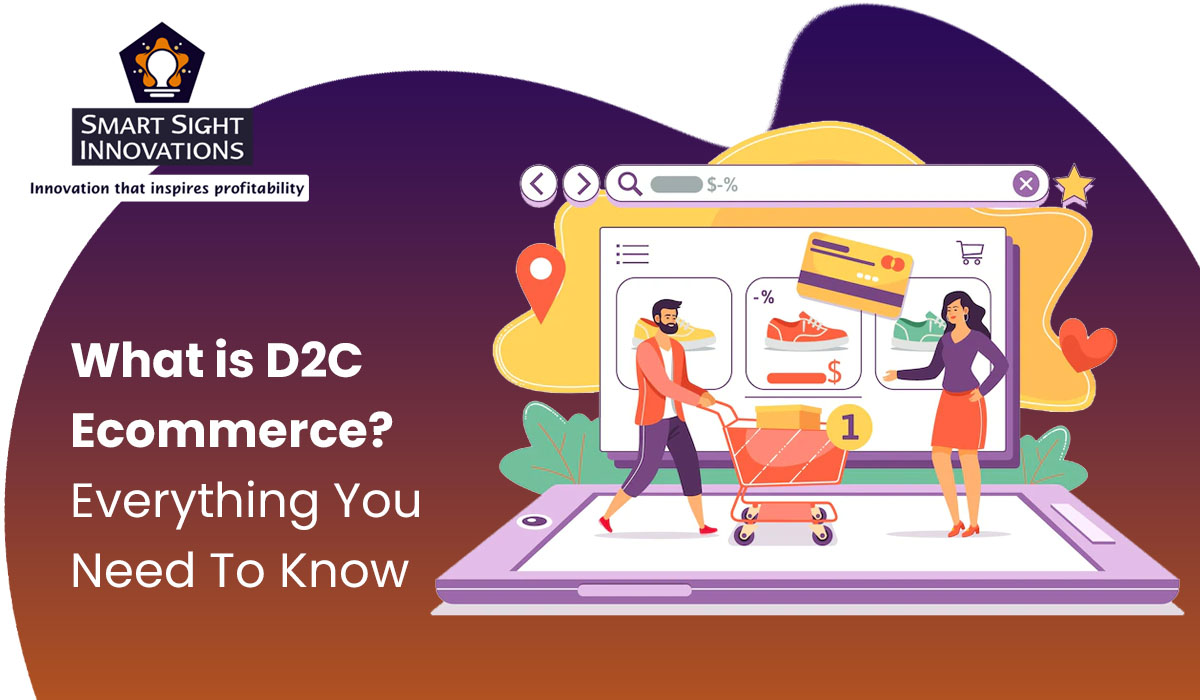Exploring the Potential of D2C Ecommerce: A Comprehensive Overview for Businesses
The D2C ecommerce model provides a substantial change in how brands involve with consumers. It enables business to bypass conventional retail channels, cultivating much deeper links and possibly increased revenue margins. Nonetheless, this technique is not without its complexities. Comprehending the nuances of D2C ecommerce is essential for brands intending to grow. What techniques can they take on to navigate this progressing landscape properly? The answers may redefine their business approaches.
Recognizing the D2C Ecommerce Design

Key Conveniences of D2C Ecommerce for Brands
The D2C ecommerce version provides brands considerable benefits, particularly regarding increased earnings margins. By eliminating middlemans, companies can preserve a bigger share of sales revenue. In addition, this direct partnership with customers cultivates enhanced brand name commitment, encouraging repeat purchases and long-lasting engagement.
Increased Revenue Margins

Enhanced Brand Commitment
Building on the financial benefits of D2C ecommerce, enhanced brand commitment arises as one more essential benefit for firms involving directly with customers. By establishing a direct connection, brand names can foster much deeper relationships with their clients, getting insights into habits and preferences. This straight communication permits more personalized advertising and marketing methods, which resonate strongly with consumers. Additionally, brands have the chance to control their messaging and client experience, enhancing brand name worths and developing trust fund. When consumers feel an individual connection, they are most likely to return, support for the brand, and take part in neighborhood involvement. Ultimately, boosted brand loyalty not just drives repeat acquisitions but also grows an enthusiastic customer base, more solidifying a brand's setting in the marketplace.
Difficulties Dealt With by D2C Brands
D2C brand names experience several substantial obstacles that can affect their success. Stock management concerns can result in equip scarcities or excess, complicating procedures and consumer fulfillment. In addition, advertising spending plan restrictions typically limit the capacity to successfully involve and get to target audiences.
Supply Monitoring Issues
Efficient inventory monitoring offers a powerful obstacle for many brand names running in the direct-to-consumer (D2C) room. These brands usually grapple with rising and fall need, which can bring about overstock or stockouts, ultimately impacting client contentment and revenue. Additionally, the absence of advanced supply monitoring systems can cause disparities in between actual supply levels and reported data, complicating order satisfaction. The diverse variety of products D2C brands typically offer additionally makes complex supply administration, as variants in designs, colors, and sizes require even more thorough oversight. Additionally, numerous D2C businesses may deal with limited warehousing capacities, bring about ineffective use room and sources. As a result, effective inventory monitoring remains an important obstacle for D2C brand names intending for sustainable development and functional efficiency.
Advertising Budget Plan Constraints
Steering marketing spending plan restraints is a considerable challenge for numerous direct-to-consumer (D2C) brands. Restricted financial sources usually limit these business' ability to purchase all-inclusive advertising techniques, causing lowered visibility in an open market. D2C brands frequently come to grips with the demand to take full advantage of roi (ROI) while targeting particular target markets successfully. This difficulty is intensified by climbing prices in digital advertising and the need to designate funds throughout numerous channels, consisting of social media, search engines, and email marketing. Numerous D2C brand names must innovate cost-effective advertising and marketing services, leveraging natural growth strategies and influencer collaborations. Ultimately, successfully navigating these budget plan restrictions is vital for maintaining growth and achieving long-lasting success in the developing ecommerce landscape.
Approaches for Developing a Successful D2C Ecommerce Service
As consumers progressively seek direct links with brands, developing a successful D2C ecommerce service calls for a critical technique that prioritizes client interaction and trust fund. One efficient approach is to create compelling brand name narratives that reverberate with target market, cultivating emotional connections. Utilizing social media platforms can enhance exposure and facilitate two-way interaction, enabling brands to engage straight with customers.Moreover, individualized experiences via customized advertising and marketing initiatives can substantially enhance client retention and loyalty. Carrying out commitment programs and supplying exclusive offers can even more incentivize repeat purchases.Streamlining the acquiring process is necessary, making certain an user-friendly interface that enhances the purchasing experience. In addition, clear interaction regarding shipping and returns constructs depend on and encourages consumer confidence.Finally, proactively looking for consumer responses and replying to it demonstrates a commitment to improvement and customer contentment, crucial elements in the affordable D2C landscape.
Leveraging Modern Technology for Boosted Customer Experience
In today's competitive D2C ecommerce landscape, innovation plays a crucial function fit client experiences. Services significantly use sophisticated devices such as synthetic intelligence, chatbots, and customized algorithms to improve interactions and simplify the shopping process. By incorporating these innovations, brand names can provide customized item suggestions based upon specific choices and purchasing habits, promoting a much more appealing experience.Moreover, receptive internet site designs and mobile applications assure that customers can access services flawlessly across various devices. Boosted repayment remedies, consisting of one-click check outs and electronic pocketbooks, better simplify transactions, making it easier for customers to make purchases.Data analytics likewise enables businesses to collect understandings into customer habits, enabling continual enhancement of solutions and offerings. On the whole, leveraging innovation not only improves customer fulfillment yet additionally cultivates commitment, eventually driving long-lasting success in the look at this site D2C ecommerce industry.
Advertising And Marketing Techniques to Drive D2C Sales
How can brands successfully capture the attention of customers in a saturated market? To grow in the direct-to-consumer (D2C) landscape, brand names need to employ targeted advertising techniques. Using social media sites platforms, brands can click now involve customers via interactive web content, influencer collaborations, and user-generated posts. Customized email campaigns can also promote a sense of connection, using tailored promos based upon customer habits and preferences.Moreover, narration plays a vital function in differentiating a brand name's story, making it unforgettable and relatable. Brands need to buy seo (SEARCH ENGINE OPTIMIZATION) to improve exposure, guaranteeing their items are easily visible online. Additionally, leveraging information analytics permits services to improve their marketing approaches and comprehend consumer fads better. Ultimately, a multi-channel method that combines imagination with data-driven insights can substantially enhance D2C sales, enabling brands to stick out in a congested industry.
Future Trends in D2C Ecommerce
With the quick development of technology and customer choices, the future of D2C ecommerce is poised for substantial transformation. Arising fads suggest a change in the direction of hyper-personalization, where brands take advantage of information analytics to tailor offerings to private customer demands. This modification boosts consumer experiences, promoting loyalty and engagement.Moreover, sustainability is ending up being an essential element, with consumers progressively favoring brands that focus on environmentally friendly techniques - D2C Ecommerce Agency. Business are expected to embrace transparent supply chains and sustainable materials to fulfill this demand.The assimilation of expert system and increased reality will furthermore revolutionize the buying experience, allowing consumers to imagine products in their environments prior to acquisition. Additionally, social business is anticipated to grow, as platforms like Instagram and TikTok assist in seamless purchasing experiences straight within social media.These trends collectively signify a vibrant future for D2C ecommerce, emphasizing customer-centric techniques and innovative modern technologies that redefine customer interactions
Often Asked Inquiries
What Industries Advantage The Majority Of From D2C Ecommerce?
The present question highlights industries that thrive via direct-to-consumer (D2C) ecommerce. Extremely, style, charm, electronic devices, and food markets utilize D2C versions to enhance brand commitment, enhance client relationships, and optimize profit margins properly.
Just How Do Shipping Expenses Influence D2C Pricing Techniques?
Delivering costs significantly affect D2C rates approaches. Businesses must stabilize these expenditures with competitive prices, taking into consideration customer assumptions and profit margins. Effective monitoring of shipping can enhance consumer fulfillment and drive sales in direct-to-consumer models.
What Payment Alternatives Should D2C Services Deal?
D2C organizations ought to offer diverse settlement alternatives, consisting of credit/debit cards, electronic pocketbooks, and purchase currently, pay later on solutions. This selection enhances client convenience, boosts conversion rates, and accommodates various customer preferences in the on the internet shopping landscape.
How Can D2C Brands Handle Client Returns Successfully?
D2C brands can manage customer returns successfully by applying easy to use return plans, providing pre-paid delivery labels, and making sure punctual reimbursements (D2C Ecommerce Agency). Clear interaction and structured processes enhance customer satisfaction and urge repeat business
What Lawful Factors To Consider Exist for D2C Ecommerce Operations?
Legal factors to consider for D2C ecommerce operations include conformity with customer protection legislations, data personal privacy laws, intellectual residential property civil liberties, and taxes demands. Brand names have to browse these intricacies to avoid legal mistakes and ensure smooth operations. By eliminating intermediaries, D2C brand names can provide affordable prices and cultivate a much more intimate connection with their customers.The D2C design is characterized by its dependence on electronic platforms, making it possible for brand names to utilize social media, on the internet industries, and their very own internet sites to engage with consumers directly. D2C ecommerce facilitates the collection of useful consumer data, allowing brands to customize their offerings and advertising and marketing strategies effectively, eventually driving sales and raising margins. In addition, brands have the chance to control their messaging and consumer experience, strengthening brand name values and constructing depend on. As other customers progressively seek straight links with brands, establishing a successful D2C ecommerce organization requires a calculated method that focuses on client interaction and trust fund. D2C brands can take care of client returns properly by executing user-friendly return policies, offering pre-paid shipping tags, and making certain punctual reimbursements.